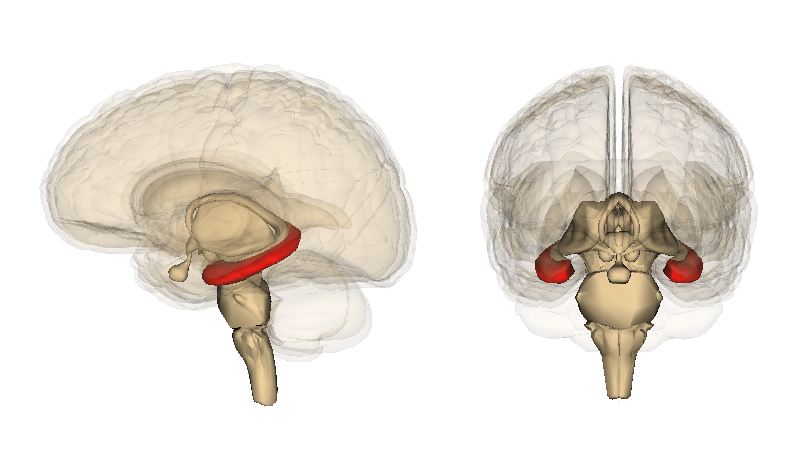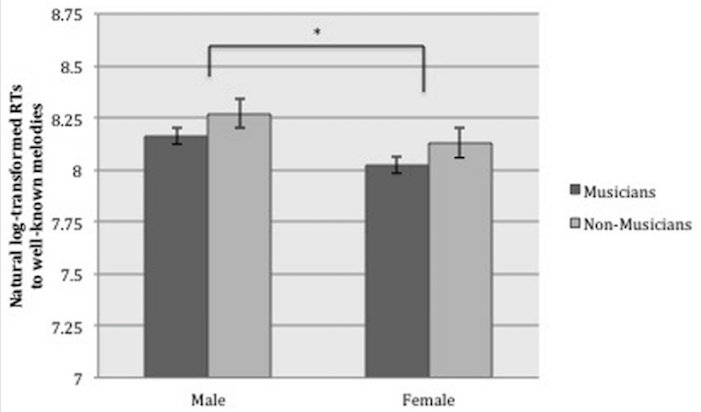Title of paper under discussion
Sex Differences in Music: A Female Advantage at Recognizing Familiar Melodies
Authors
Scott A. Miles, Robbin A. Miranda, and Michael T. Ullman
Journal
Frontiers in psychology vol. 7, 278; 1 March 2016
Link to paper (free access)
Overview
Working in the Brain and Language Laboratory of Georgetown University, Washington DC, Scott Miles and his team set out to test the prediction that women would be quicker than men at recognising familiar melodies. The prediction was based on previous findings that 1) women have better declarative memory, the type of memory including specific personal experiences and factual information, and 2) recognition of familiar melodies take place in the brain area housing declarative memory.
Two groups of people – one group male, the other female – took part in the study. On being presented with a series of familiar and novel melodies the participants were asked “to indicate their recognition of familiar melodies as fast as possible”. Overall the women were significantly faster than the men in responding, and equally accurate. Better declarative memory has previously been shown to give women an advantage in certain tasks involving verbal material, but this study went on to demonstrate that women’s musical recognition superiority was not due to their associating the melodies with lyrics. Such a female declarative memory advantage, evident in verbal and now in musical tasks, would suggest that music and language may depend, at least in part, on a common memory system.
Introduction

Declarative memory – the memory system underlying “the learning, storage, and retrieval of explicit knowledge, which is available to conscious awareness“ – is “rooted in the hippocampus and other structures in the medial temporal lobe of the brain”. The hippocampus (shaped like a seahorse, hence its name) “seems to develop at a faster rate, with respect to the rest of the brain, in girls than in boys between the ages of one and sixteen.” This difference “may be mediated by oestrogen, which is found in higher levels in girls and (pre-menopausal) women than in boys and men…and affects declarative memory and hippocampal structure and function..”

According to this paper’s authors “increasing evidence suggests a female advantage at declarative memory”. Examples they cite include women scoring better at memory tests on “verbal material, landmarks, objects, object locations, novel faces, and complex abstract patterns.”

So does the female advantage at declarative memory help in musical processing? Scott Miles and his team reasoned that a musical skill that might well involve declarative memory is the ability to recognise ‘familiar melodies’ – a skill that was already strongly suspected from electroencephalography (EEG) experiments to be located in the medial temporal lobe, the home of declarative memory.
Scientists had already looked for sex differences in another aspect of musicianship – processing musical syntax – and had found them… but only in EEG readings, not in how well the different sexes performed in musical syntax tasks. Musical syntax had, anyhow, been shown to be processed along a different brain pathway from ‘familiar melody’ memory.
So in their search for a musical form of declarative memory, one which might reveal a female advantage, our researchers decided to focus on ‘familiar melody’ memory – specifically how quickly and accurately participants could indicate whether or not they were familiar with a melody.
Method
Two groups of participants, 24 men and 24 women, were assembled, each group comprising 12 musicians and 12 non-musicians. The groups were matched for age, years of education, handedness and (for the musicians) years of musical training.
Each participant was presented with 260 melodies. Half of these (130) were segments of well-known tunes (including “traditional, folk, children’s, patriotic, holiday, classical and pop music, as well as themes from movies, television and Broadway musicals”). The other half were “novel melodies” composed by Robbin Miranda, one of the paper’s authors.
Over three runs (of about 15 minutes each) all 260 melodies, in randomised order, were played to a participant seated in front of a computer, with the instruction “to press the space bar as soon as the melody sounded familiar”.
The melody ran to its full length whether or not the space bar was pressed; the participant was then asked to rate the familiarity of each melody from 1 to 100, straight after each one had finished.
(As a reaction time control study, after the main experiment, participants were presented with 20 simple tones, with varying silent time intervals in between, and were asked to press the space bar as soon as they heard each one).
Results

As the graph above demonstrates, women – both musicians and non-musicians – were indeed significantly faster than men at recognising familiar melodies. There was also a “tendency for musicians to respond faster than non-musicians”.
In order to assure themselves that this “female advantage” result was not due to factors other than sex differences in memory, the authors conducted extra statistical analyses to rule out possible “confounding factors”:
1) Familiarity. There was a significant correlation between a participant’s recognition reaction time, and the familiarity rating given, to a given melody. So were women “faster at responding to well-known melodies simply because they were more familiar with the melodies, as compared with men”? When familiarity ratings were factored out of the analysis, the same result emerged – women were quicker than men at responding. It wasn’t because they were more familiar with the music.
2) Response bias. Perhaps women were more prone to pressing the space bar quickly for all melodies, familiar or not? The analysis said not.
3) Lyrics recognition. We already know that women’s superior declarative memory makes them quicker at certain verbal tasks. Maybe the female speed advantage in recognising familiar melodies might be because those melodies are associated with lyrics, so triggering verbal associations? If this were so, the female advantage would only be apparent on hearing melodies associated with lyrics; an analysis of the data showed this was not the case.
4) Motor skills. Do women simply have quicker reaction times to an auditory stimulus, regardless of whether it is a familiar melody or not? This possible confound was ruled out using the control study described above in which participants reacts only to the presentation of simple tones – women were no quicker at this task than men.
Discussion
Through the results of this investigation, Scott Miles and his colleagues strengthened the case for believing that the processing of familiar melodies involves declarative memory, with the known female advantage in declarative memory holding fast for melody recognition.
Intriguingly the authors suggest towards the end of the paper that there may be more than one way for a brain to process music, and that women may tend to use declarative memory where men might use other forms of memory (e.g. procedural memory), for example when processing musical syntax. They compare this to verbal language processing, where “girls and women seem to rely more on declarative memory than boys and men for aspects of grammar, likely due to the female advantages at declarative memory”.
What of the implications of this paper’s findings? The authors remind us that declarative memory has been “well studied at multiple levels” so if, as this study suggests, it is an important feature of musical cognition then “this vast independent knowledge about the [declarative] memory system could also pertain to music cognition”. Another inference from the study is that music and verbal language are, at least in part, being processed in “general-purpose brain systems”, which may help to “clarify commonalities between the cognition of music and language”.
Perhaps most importantly, the authors suggest that their findings have educational and clinical implications: “pedagogical techniques that have been shown to improve learning and retention in declarative memory, such as spaced presentation….may also be expected to enhance music learning, in particular the learning of specific melodies”.
Coda
“Anything You Can Do I Can Do Better”
Betty Hutton and Howard Keel, from “Annie Get Your Gun”